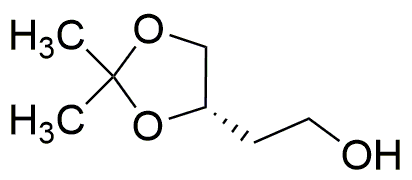(S)-4-(2-Hydroxyethyl)-2,2-dimethyl-1,3-dioxolane is widely utilized in research focused on:
- Pharmaceutical Development: This compound serves as a building block in the synthesis of various pharmaceutical agents, enhancing drug efficacy and stability.
- Cosmetic Formulations: Its properties make it an excellent ingredient in skin care products, providing moisturizing effects and improving product texture.
- Polymer Chemistry: Used in the production of specialty polymers, it contributes to materials with improved flexibility and durability, ideal for coatings and adhesives.
- Biochemical Research: The compound is valuable in studies involving enzyme activity and metabolic pathways, aiding researchers in understanding biological processes.
- Flavor and Fragrance Industry: It acts as a flavoring agent, enhancing the sensory profile of food and beverages, while also being used in perfumes for its pleasant aroma.
General Information
Properties
Safety and Regulations
Applications
(S)-4-(2-Hydroxyethyl)-2,2-dimethyl-1,3-dioxolane is widely utilized in research focused on:
- Pharmaceutical Development: This compound serves as a building block in the synthesis of various pharmaceutical agents, enhancing drug efficacy and stability.
- Cosmetic Formulations: Its properties make it an excellent ingredient in skin care products, providing moisturizing effects and improving product texture.
- Polymer Chemistry: Used in the production of specialty polymers, it contributes to materials with improved flexibility and durability, ideal for coatings and adhesives.
- Biochemical Research: The compound is valuable in studies involving enzyme activity and metabolic pathways, aiding researchers in understanding biological processes.
- Flavor and Fragrance Industry: It acts as a flavoring agent, enhancing the sensory profile of food and beverages, while also being used in perfumes for its pleasant aroma.
Documents
Safety Data Sheets (SDS)
The SDS provides comprehensive safety information on handling, storage, and disposal of the product.
Product Specification (PS)
The PS provides a comprehensive breakdown of the product’s properties, including chemical composition, physical state, purity, and storage requirements. It also details acceptable quality ranges and the product's intended applications.
Certificates of Analysis (COA)
Search for Certificates of Analysis (COA) by entering the products Lot Number. Lot and Batch Numbers can be found on a product’s label following the words ‘Lot’ or ‘Batch’.
*Catalog Number
*Lot Number
Certificates Of Origin (COO)
This COO confirms the country where the product was manufactured, and also details the materials and components used in it and whether it is derived from natural, synthetic, or other specific sources. This certificate may be required for customs, trade, and regulatory compliance.
*Catalog Number
*Lot Number
Safety Data Sheets (SDS)
The SDS provides comprehensive safety information on handling, storage, and disposal of the product.
DownloadProduct Specification (PS)
The PS provides a comprehensive breakdown of the product’s properties, including chemical composition, physical state, purity, and storage requirements. It also details acceptable quality ranges and the product's intended applications.
DownloadCertificates of Analysis (COA)
Search for Certificates of Analysis (COA) by entering the products Lot Number. Lot and Batch Numbers can be found on a product’s label following the words ‘Lot’ or ‘Batch’.
*Catalog Number
*Lot Number
Certificates Of Origin (COO)
This COO confirms the country where the product was manufactured, and also details the materials and components used in it and whether it is derived from natural, synthetic, or other specific sources. This certificate may be required for customs, trade, and regulatory compliance.

